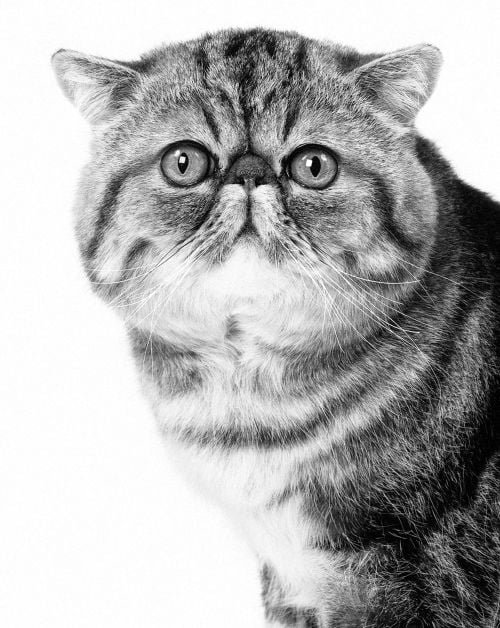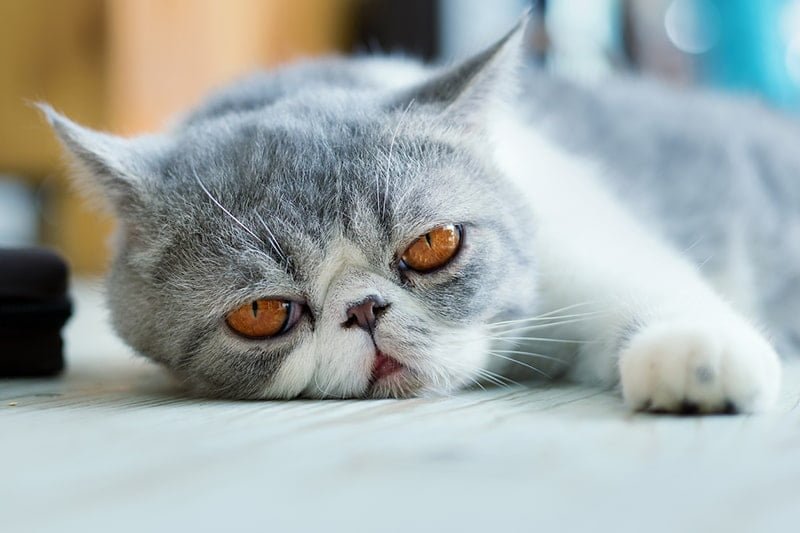
True to its namesake, the Exotic Shorthair is unlike any other ordinary cat in terms of appearance. Almost every part of its body is round, with stumpy limbs and a thick tail to accentuate its overall rotund form. Hence, it also goes by the nickname “teddy bear cat.”
The Exotic Shorthair is a crossbreed of purebred Persians and American Shorthairs – although it also shares marginal ancestry with the Burmese and a Russian Blues. A significant portion of its pedigree comes from its Persian ancestors.
Curiously, there is more to this cat than just its lovable appearance. The Exotic Shorthair is also one of the gentlest breeds on earth.
In reality, teddy bear cats are unlike the infamously daring and troublesome Garfield ‘misrepresenting’ their kind.
The earliest documented occurrence of this feline breed dates back in the 1950s – with the Championship status granted by the Cat Fancier’s Association (CFA) in 1967. As of 2018, CFA hailed the Exotic Shorthair as the most popular breed ever.
Contents
Average Cost of an Exotic Shorthair
Being the most popular cat as of date, it is natural for prospective pet owners to covet such an endearing creature. This fame naturally influences the cost, especially if you aim to buy its custodianship from highly competitive breeders.
The rule of thumb is to acquire a pet from a cattery that has a solid reputation. It has to be certified by national/global feline organizations like the aforementioned CFA.
Other registries worth noting include The International Cat Association (TICA), World Cat Congress (WCC), and World Cat Federation (WFC).
A California-based TICA-accredited breeder called Polaris Cattery charges up to $2,200 for a young Exotic Shorthair – excluding the $375 shipping fee to any airport in the United States.
It is relatively cheaper to buy an adult Exotic Shorthair. A Ukraine-based WFC-certified cattery called Sweet Beast offers a breeding price for as low as $150.
How is a Cat/Kitten Valued?
As featured by the figures mentioned earlier, the gulf in terms of exact price is too apparent (if not outright devious). Nevertheless, the manner in which costs are determined is far from just random or whimsical.
There are a number of factors that affect such numbers, all of which can be pigeonholed in two major categories – age and physical characteristics.
Adult cats normally fetch a lower price since age entails a number of ‘accumulated impurities.’ The older the cat gets, the more at risk it is for a number of hereditary and environmental conditions.
Even if a breeder would guarantee that their Exotic Shorthairs are free of prevalent diseases, cats (like all creatures) do not get healthier as they age. The value of this popular feline breed is always subject to eugenics.
Price variation in terms of age is easier to determine. But costing based on the Exotic Shorthair’s appearance seems sketchy for most laypeople (non-breeders) at best.
It is worth mentioning that, as a fierce contender of current popularity rankings, there are calculable standards that determine how beautiful (and therefore expensive) an Exotic Shorthair is. Here is an example of a basic scoring formula by the WCF:
- Head – 30 points
- Coat color & texture – 30 points
- Body – 20 points
- Eye color – 15 points
- Condition – 5 points

Why Adopt Instead?
Considering everything that is said in the earlier part of this article, should availing for a bargain Exotic Shorthair price means compromising its overall quality in terms of aesthetics and wellness?
Since eugenics (and the breeder’s reputation) pretty much determine its monetary value, you may automatically assume that low-cost Exotic Shorthairs are relatively deformed and/or unhealthy. Fortunately, it takes a change of perspective to define how certain animal companions are valued.
Proponents of pet adoption (as fiercely opposed to purchasing from breeders) believe that the principles of charity and parental love outweigh prestige and appearance. As a result, the caring of these cats in foster homes is simply motivated by the passion to keep them alive and well.
Adopting an Exotic Shorthair is a matter of redeeming it from permanent abandonment, or even death (euthanasia). The basis for its cost is not only simpler to comprehend; the price itself is also relatively cheaper.
A Wisconsin-based foster home called Purebred Rescue provides the following price ranges for the different groups of feline candidates:
- Domestic cats: $50 to $125
- Purebred mix cats: $75 to $175
- Purebred cats: $100 to $400
- Rare purebred cats: $250 to $600
Overall Living Expenses
If the purchasing price of an Exotic Shorthair is determined by its overall appearance, it is fair to say that the subsequent expenses of raising them are decided by their health and psychological profile.
This cat’s gentle side is not only limited to its meek and affectionate nature. It also tends to be relatively fragile creatures – not bred for roughhousing and acrobatics.
When it comes to Exotic Shorthairs’ stewardship, the rule of thumb is to keep them indoors in order to avoid a seemingly endless list of physical perils (which translates to costly emergency medical expenses). Keeping them indoors also means spending on things that will keep them occupied in the absence of curiosities found in the outside world.
In-depth knowledge of their health and psychological profile can provide a keener insight in terms of how much you can wisely spend on their welfare. Consider the following lifestyle aspects of an Exotic Shorthair, for which some would require special needs/preferences:
- Feeding
Unlike other feline animal companions, there is a different formula in terms of feeding Exotic Shorthairs. Experts would strongly advise a diet that consists of 80% canned (wet or moist) food and 20% dry or raw.
This preference is driven by their extremely high likelihood of suffering from dental issues and progressive kidney problems.
- Pack of 24 canned foods (5.5 oz each): Up to $47
- A 5-pound bag of dry food: Up to $17
- 7 kilos of raw meat (chicken breast fillets): Up to 47
- Hygiene
Although the Exotic Shorthairs have inherited much of their genetic features from their Persian parentage, these cats have a good fortune of having shorter hair. This means they require less grooming (or the likelihood of swallowing hairball).
Unfortunately, the same cannot be said about their flat face. Their brachycephalic skull structure causes poor fluid drainage from their orifices (e.g. tears and snot).
In other words, you will need to regularly clean their eyes and examine it for redness, cloudiness or abnormal discharges. This is another strong reason to emphasize the need for a tearless shampoo.
- Metal-toothed comb: Up to $17
- Gentle wire brush: $7 to $9
- Medicated wipes: $11 to $20
- 12-oz shampoo: Up to $7
All feline animal companions require a cat litter for them to relieve themselves – all the more so for strictly indoor varieties like the Exotic Shorthair. However, it is worth considering the fact that they are generally very shy felines.
Take note of the possible higher standards of privacy for an act that needs discretion. It is best for them to be able to comfortably remain unseen (especially by strangers) while they do their thing.
- 40-pound cat litter: Up to $19
- Litter pan/box: Up to $11
- Litter box enclosure: Up to $77
- Equipment
Being on the gentle side has made the Exotic Shorthair cats relatively easy to entertain. They prefer low-key play and they make excellent lap cats.
Due to their strong tendency to become overweight, you should buy toys that promote ingenious methods of weight control.
While there is little to no issue when it comes to their ability to keep themselves preoccupied, they are very prone to separation anxiety. If left alone for a very long time, they might suffer depression or (worse) try to escape.
Remember the golden rule: keep them indoors! Experts recommend keeping the television or radio on in order to mask your absence, in case you need to be away for work or other important appointments.
Illness or stress can somehow provoke unusual behaviors among cats. Exotic Shorthairs might not be so different when it comes to the habit of hiding as a desperate coping mechanism.
So what’s the problem?
Exotic Shorthairs are very quiet creatures. The last thing you need is to wonder in panic whether or not your little teddy bear has escaped after spending an entire day trapped in an ‘involuntary game of hide-and-seek’.
- Puzzle feeder: Up to $30
- Cat wand: Up to $12
- Bell collar: Up to $10
- GPS tracker collar: Up to $80
- Microchip surgery: Up to $40
- Cat carrier: Up to $21
- Health
There can be little doubt that medical costs take the cake in terms of the overall expenses of raising a pet cat.
Exotic Shorthairs can live an average lifespan of 15 years. This means maintaining 15 annual checkups, up to 5 rabies shots, once-in-a-lifetime sterilization (neuter/spay), and an occasional need for emergency treatment in case they suffer a serious injury or infection should be considered.
A New York-based facility called Union Street Veterinary Hospital offers the following services catering to the feline animal companion’s basic health requirements:
- Annual checkups: $55
- Recheck exam: $25
- Emergency walk-in exam: $75
- Sterilization (via Spay USA): $20
- Rabies vaccine: $27
- FVRCP vaccine: $27
- Leukemia test: $45
- Leukemia vaccine: $27
- Stool analysis: $27
In order to have a more secure financial safety net, it would be highly recommended to pay a nominal periodic fee for pet insurance.
Certain emergency treatments (e.g. surgery) would cost thousands of dollars. Yet in the area of sickness and health, the odds of expensive trauma operations can be the least of your worries.
One of the most notable disadvantages of adopting an Exotic Shorthair has something to do with its health. As a huge tradeoff for its lovable physical features, this breed is genetically predisposed to at least 10 of the following hereditary conditions:
- Heart disease (cardiomyopathy)
- Brachycephalic syndrome
- Eye disease (e.g. cataract)
- Urinary tract disease
- Polycystic kidney disease
- Hip dysplasia
- Liver shunt
- Infectious peritonitis
- Leukemia
- Dystocia
